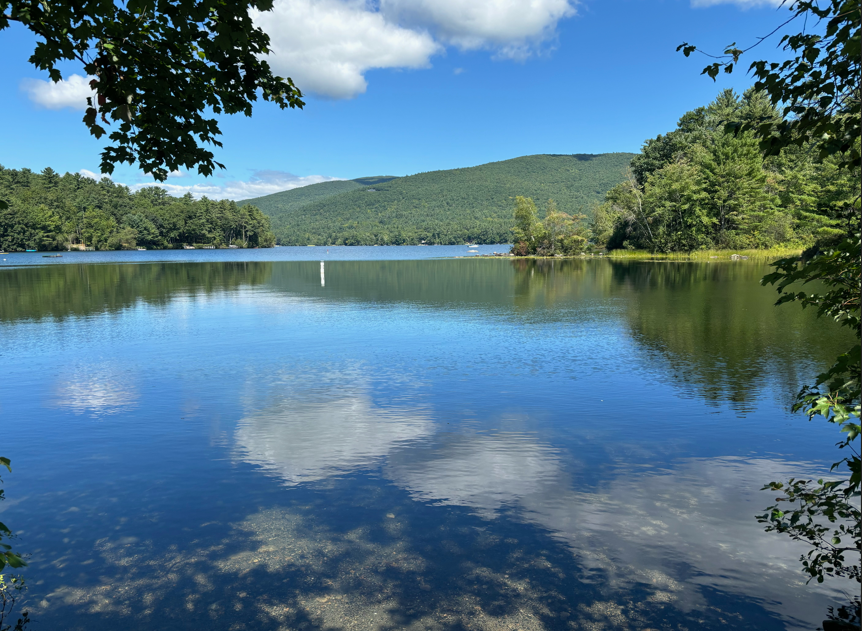By PAULA TRACY, InDepthNH.org
MOULTONBOROUGH – Lake Kanasatka now has its first cyanobacteria watch issued for 2024 after the lake association has taken efforts to fight the problem.
Dark clumps of material were reported on Tuesday and a cyanobacteria watch was issued by the state Wednesday, particularly for the southeast and west shorelines.
Also seeing its first cyanobacteria watch for this summer is Lake Francis in Pittsburg and Clarksville, which was issued on Monday with greet clots photographed.
While the state Department of Environmental Services said the water there in Coos County has not yet been analyzed, it issued the watch based on the photographs submitted.
As the unofficial last weekend of the summer approaches, the three-day Labor Day weekend will unfortunately be impacted by 12 cyanobacteria warnings now up and five watches, with several areas on Lake Winnipesaukee impacted by the potentially toxic material floating in the lake.
The state advises against swimming in those areas and has a motto of “when in doubt, stay out.”
Lake Kanasatka, with a capital campaign, grants, shore owner pledges to be “Lake Smart” and alter their property to prevent storm runoff, spent $800,000 in the spring to treat the lake to fight cyanobacteria blooms which have plagued them since 2021.
A pilot treatment of alum was applied in phases in May which holds the material down in the lake bed.
And until this week, the lake had been clear.
Kevin Kelly, who is a leader in the Lake Kanasatka Watershed Association posted on its Facebook page for lake observers to look for dark green or tar like globs on the bottom of the lake.
Asked by one person if it made sense to remove it and dispose of it, he replied “we need to find the source of the problem and address it there. We can do this!”
DES also reported many sightings of the unique cyanobacteria called Gloeotrichia, primarily in the Wolfeboro and Alton areas.
Lake Wentworth has also had reports.
The colonies look like very small, fuzzy balls in the water. Each colony of Gloeotrichia may contain approximately 5,000 cells. They can appear either green or sometimes brownish-yellow by eye.
“Oftentimes, these cyanobacteria stay suspended in the water and do not accumulate to large concentrations. Under certain conditions, however, they can accumulate along shorelines in more dense concentrations of material, occasionally forming green or yellow clouds or surface scums. Oftentimes these accumulations do not last long and become mixed back into the water to lower densities. These blooms can rapidly change and accumulate in various locations around a waterbody. Please monitor your individual shorelines for changing conditions and avoid contact with areas with dense accumulations, please also keep pets out. If the density looks low, the risk of recreating in that water should be low,” the DES press release reads.
New Hampshire researchers are studying Gloeotrichia cyanobacteria and the state lists programs as the Dartmouth College Gloeotrichia Project; The Lake Sunapee Protective Association and UNH Center for Freshwater Biology.
This problem has been growing in the state since the 1970s but seems to have exploded this summer after a particularly warm winter with little ice. Biologists say the ice allows for a reset button of sorts to slow growth.
Also warmer water helps feed the toxic problem.
Cyanobacteria are natural components of water bodies worldwide, though blooms and surface scums may form when excess nutrients are available to the water.
Some cyanobacteria produce toxins that are stored within the cells and released upon cell death.
Toxins can cause both acute and chronic health effects that range in severity. Acute health effects include irritation of skin and mucous membranes, tingling, numbness, nausea, vomiting, seizures and diarrhea. Chronic effects may include liver and central nervous system damage. Be cautious of lake water that has a surface scum, changes colors, appears cloudy or has green streaks or blue-green flecks.
As of this writing on Thursday morning, the DES was reporting 12 cyanobacteria warnings and one that dates back as being identified on Aug. 2 at Province Lake in Wakefield.
Also, for a long time dealing with this problem is Baboosic Lake in Amherst. It was found Aug. 15 and is remaining on the list as those on the list are tested each week and either come off or continue.
On Lake Winnipesaukee, warnings are issued for Governor’s Island, The Broads, Wolfeboro while watches are in effect for Alton and Tuftonboro.
Warnings are also on Pool Pond in Rindge, Lake Monomonac in Ridge, Keyser Pond in Henniker, Arlington Mill Pond in Salem and Showell Pond in Sandown.
There is also a watch issued now including Long Pond in Henniker. The list changes frequently so check for updated information at https://www.des.nh.gov/water/healthy-swimming/harmful-algal-blooms





